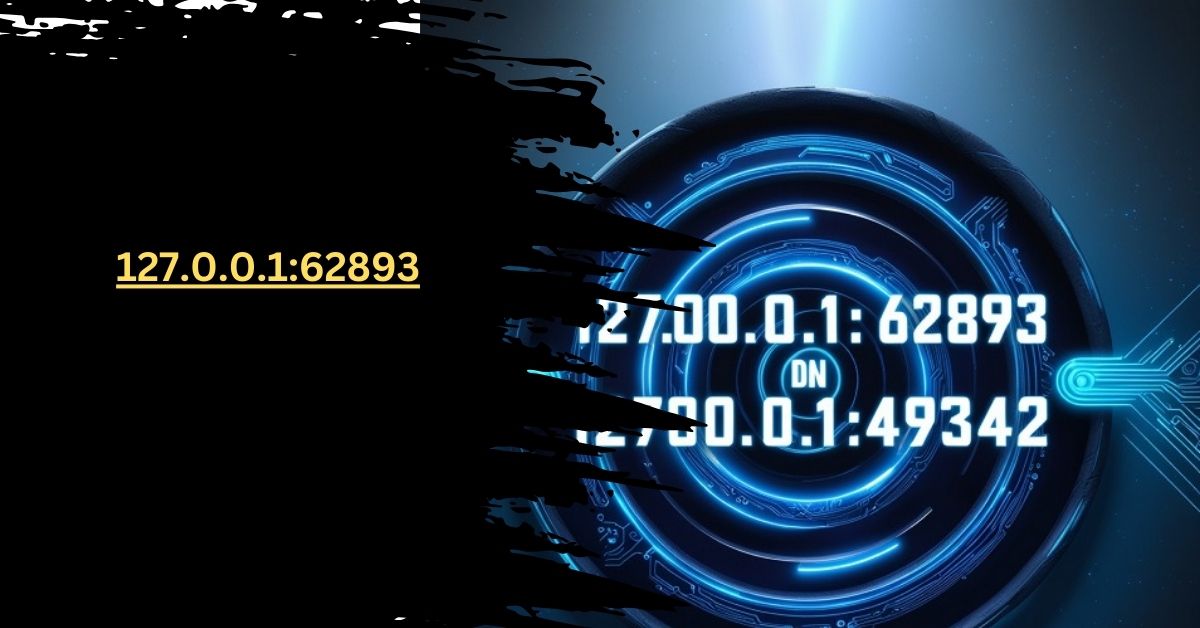Understanding 127.0.0.1:62893: Your Gateway to Local Networking
Have you ever come across the mysterious string of numbers “127.0.0.1:62893” and wondered what it means? Don’t worry, you’re not alone! This article will break down everything you need to know about this important network address in simple, easy-to-understand language. Whether you’re a curious beginner or someone looking to expand their tech knowledge, we’ve got you covered. Let’s dive in and unravel the secrets of 127.0.0.1:62893!
What is 127.0.0.1:62893?
Before we get into the specifics, let’s break down this string of numbers and symbols:
- 127.0.0.1: This is a special IP address known as the “localhost” or “loopback” address.
- : (colon): This symbol separates the IP address from the port number.
- 62893: This is a specific port number.
So, 127.0.0.1:62893 is actually referring to a combination of an IP address (127.0.0.1) and a port number (62893). But what does that really mean? Let’s explore each part in more detail.
The Magic of 127.0.0.1: Your Computer’s Home Address
Imagine your computer as a house in a big neighborhood called the internet. Every house needs an address so that messages and visitors know where to go. In the world of computers, these addresses are called IP addresses.
127.0.0.1 is a very special address. It’s like your computer’s home address, but it’s always the same for every computer! When a program on your computer wants to talk to itself or another program on the same computer, it uses this address.
Some fun facts about 127.0.0.1:
- It’s often called “localhost” because it’s the local host (your computer).
- It’s also known as the “loopback” address because any data sent to it loops back to your own computer.
- You can think of it as your computer talking to itself in the mirror!
What’s the Deal with Port 62893?
Now that we understand the IP address part, let’s talk about the number after the colon: 62893. This is called a port number.
If we stick with our house analogy, think of ports as different doors or windows in your house. Just like you might use the front door for visitors and the back door for bringing in groceries, your computer uses different ports for different types of communication.
Some key points about port 62893:
- Port numbers can range from 0 to 65535.
- Ports below 1024 are usually reserved for specific, well-known services.
- 62893 is in the range of “dynamic” or “private” ports, which can be used by any application.
Why is 127.0.0.1:62893 Important?
You might be wondering why we’re making such a big deal about this particular address and port. Here’s why it matters:
- Local Development: When you’re creating websites or apps, you often test them on your own computer first. 127.0.0.1:62893 could be the address where your test server is running.
- Troubleshooting: If you’re having network issues, checking connections to 127.0.0.1 can help you figure out if the problem is with your computer or the wider network.
- Security: Some malware or unauthorized programs might try to use localhost addresses to hide their activities. Understanding these addresses can help you spot suspicious behavior.
- Network Applications: Many programs use localhost addresses to communicate between different parts of the same application running on your computer.
How to Use 127.0.0.1:62893
Now that you know what 127.0.0.1:62893 means, you might be wondering how you can actually use this information. Here are some practical ways to put your new knowledge to work:
1. Accessing Local Websites
If you’re a web developer or just curious about how websites work, you can use 127.0.0.1:62893 to access websites running on your own computer. Here’s how:
- Start a local web server on port 62893 (the exact method depends on what programming language or tools you’re using).
- Open your web browser.
- Type “http://127.0.0.1:62893” in the address bar and press Enter.
- You should see your local website!
2. Testing Network Connectivity
You can use the 127.0.0.1 address to check if your computer’s network stack is working correctly:
- Open a command prompt or terminal on your computer.
- Type “ping 127.0.0.1” and press Enter.
- If you see replies, your network stack is functioning properly.
3. Configuring Applications
Many applications allow you to set a “localhost” address and port for various functions. Now that you understand what 127.0.0.1:62893 means, you can confidently use these settings when needed.
Common Misconceptions about 127.0.0.1:62893
Let’s clear up some common misunderstandings about this address:
- “It’s my public IP address”: Nope! 127.0.0.1 is always a local address, never your public internet address.
- “The port number 62893 is special”: While this port number isn’t inherently special, it could be significant in the context of a specific application or service you’re using.
- “I can use it to access other computers”: Remember, 127.0.0.1 always refers to the local computer. You can’t use it to connect to other devices on your network.
- “It’s only for advanced users”: While it’s true that developers and IT professionals often work with localhost addresses, understanding the basics can be helpful for anyone who uses a computer!
The Bigger Picture: Understanding IP Addresses and Ports
Now that we’ve demystified 127.0.0.1:62893, let’s zoom out and look at the bigger picture of IP addresses and ports. This will help you understand how your computer communicates with the rest of the internet.
IP Addresses: The Internet’s Street Addresses
We’ve already compared IP addresses to house addresses, but let’s dig a little deeper:
- IPv4 vs IPv6: The 127.0.0.1 address is part of the older IPv4 system. There’s a newer system called IPv6 that uses longer addresses to allow for more devices on the internet.
- Public vs Private: Besides localhost addresses, there are public IP addresses (used on the internet) and private IP addresses (used within local networks, like your home Wi-Fi).
- Dynamic vs Static: Most home internet connections use dynamic IP addresses that can change, while businesses often use static IP addresses that stay the same.
Ports: Traffic Directors for Your Computer
We compared ports to doors in a house, but they’re really more like sorting stations for internet traffic. Here’s why they’re important:
- Well-known Ports: Certain ports are reserved for specific services. For example, port 80 is typically used for regular web traffic, and port 443 for secure web traffic.
- Security: Firewalls often work by blocking or allowing traffic on specific ports.
- Multiple Services: Ports allow your computer to run multiple network services at once without getting the data mixed up.
Practical Applications of Localhost in Everyday Life
You might be surprised to learn that the concept of localhost and specific ports like 62893 play a role in many things you do every day:
- Web Browsing: When you visit a website, your browser uses different ports to request different types of content (images, videos, etc.) from the web server.
- Online Gaming: Multiplayer games often use specific ports for game traffic, which is why you sometimes need to “open ports” on your router for better performance.
- Video Calls: Applications like Zoom or Skype use various ports to send and receive audio and video data.
- Smart Home Devices: Many smart home gadgets communicate with your phone or each other using local network addresses and specific ports.
- Streaming Services: When you watch Netflix or listen to Spotify, these services use different ports for different types of data transmission.
The Future of Local Networking
As technology continues to evolve, the way we use local addresses like 127.0.0.1 and ports like 62893 is also changing. Here are some trends to watch:
- IPv6 Adoption: As the internet grows, we’re slowly moving towards using IPv6 addresses, which will change how we think about localhost and local networking.
- Container Technologies: Tools like Docker are changing how developers use localhost for testing and deployment.
- Internet of Things (IoT): With more devices connecting to home networks, understanding local addressing is becoming increasingly important for everyday users.
- Edge Computing: This trend involves processing data closer to where it’s generated, often using local network resources.
- 5G Networks: The rollout of 5G technology may change how we think about local vs. remote computing resources.
Staying Safe with Localhost
While 127.0.0.1:62893 and similar addresses are generally safe to use, it’s important to keep some security considerations in mind:
- Be cautious of applications that ask for unusual localhost permissions.
- Keep your operating system and applications up to date to prevent localhost-based exploits.
- Use a firewall to control which applications can use network resources on your computer.
- Be aware that some malware may try to use localhost addresses to hide their activities.
Troubleshooting Common Issues
Even though localhost is your computer talking to itself, things can still go wrong. Here are some common issues and how to fix them:
- “Connection Refused” Errors:
- Make sure the service you’re trying to reach is actually running.
- Check if another program is already using the port you’re trying to access.
- Slow Localhost Connections:
- This could indicate a problem with your computer’s resources or configuration.
- Try restarting the application or your computer.
- Unable to Access Localhost:
- Ensure your firewall isn’t blocking the connection.
- Check your hosts file to make sure it’s not misconfigured.
- Port Already in Use:
- Use a task manager or command-line tool to find and close the application using the port you need.
Beyond 127.0.0.1:62893: Other Special IP Addresses
While we’ve focused on 127.0.0.1:62893, there are other special IP addresses you might encounter:
- 0.0.0.0: Often used to mean “any address” on the local machine.
- 192.168.0.0 to 192.168.255.255: Common private IP address range for home networks.
- 10.0.0.0 to 10.255.255.255: Another private IP address range, often used in larger networks.
- 169.254.0.0 to 169.254.255.255: “Link-local” addresses, used when DHCP fails.
Understanding these can help you navigate more complex networking scenarios.
Localhost in Different Operating Systems
The concept of localhost is universal, but how you interact with it can vary between operating systems:
Windows
- Uses the hosts file located at C:\Windows\System32\drivers\etc\hosts
- Command Prompt and PowerShell can be used for network diagnostics
macOS and Linux
- The hosts file is typically located at /etc/hosts
- Terminal provides powerful tools for working with localhost and network settings
Mobile Devices
- While less common, localhost concepts are still relevant in mobile app development
- Both Android and iOS provide localhost-like functionality for app testing
FAQs About 127.0.0.1:62893
To wrap up our comprehensive guide, let’s answer some frequently asked questions about 127.0.0.1:62893:
- Q: Is 127.0.0.1:62893 the same for everyone?
A: The 127.0.0.1 part is the same for everyone, but the port number (62893) can vary depending on the application or service you’re using. - Q: Can I change my localhost address?
A: While it’s technically possible, it’s not recommended. 127.0.0.1 is a standard that many applications rely on. - Q: Why do some applications use localhost instead of a regular IP address?
A: Using localhost ensures that the application is communicating only within the same computer, which can be faster and more secure for certain tasks. - Q: Is it safe to allow applications to use localhost addresses?
A: Generally yes, but always be cautious with unfamiliar applications and keep your system updated. - Q: Can I use 127.0.0.1:62893 to host a website for others to see?
A: No, this address is only accessible on your own computer. To host a public website, you’d need a public IP address and appropriate hosting setup. - Q: What’s the difference between 127.0.0.1 and my Wi-Fi IP address?
A: 127.0.0.1 always refers to your local computer, while your Wi-Fi IP address allows other devices on your network to communicate with your computer. - Q: Do I need to know about 127.0.0.1:62893 to use the internet?
A: For basic internet use, no. But understanding it can help with troubleshooting and more advanced computer tasks. - Q: Can malware use 127.0.0.1 addresses?
A: Yes, some malware might use localhost addresses to hide its activities or to affect your system. This is why it’s important to use reputable security software. - Q: How do I find out what’s using a specific port on localhost?
A: You can use command-line tools like ‘netstat’ on Windows or ‘lsof’ on macOS/Linux to see which applications are using specific ports. - Q: Can two applications use the same localhost port at the same time?
A: No, each port can only be used by one application at a time. This is why you sometimes encounter “port already in use” errors.
Conclusion: Mastering the Localhost
Congratulations! You’ve now gained a deep understanding of 127.0.0.1:62893 and the world of localhost addressing. From the basics of IP addresses and ports to practical applications and troubleshooting tips, you’re well-equipped to navigate the local side of networking.
Remember, while 127.0.0.1:62893 might seem like just a string of numbers, it represents an essential concept in how our computers communicate, both internally and with the wider internet. Whether you’re a budding developer, a curious tech enthusiast, or just someone who wants to understand their computer better, this knowledge will serve you well.
As you continue to explore the world of technology, keep in mind that local networking is just the beginning. The internet is a vast and complex system, and there’s always more to learn. But with your new understanding of localhost, you have a solid foundation to build upon.
So the next time you encounter 127.0.0.1:62893 or any similar localhost address, you’ll know exactly what it means and why it’s important. Happy networking!





